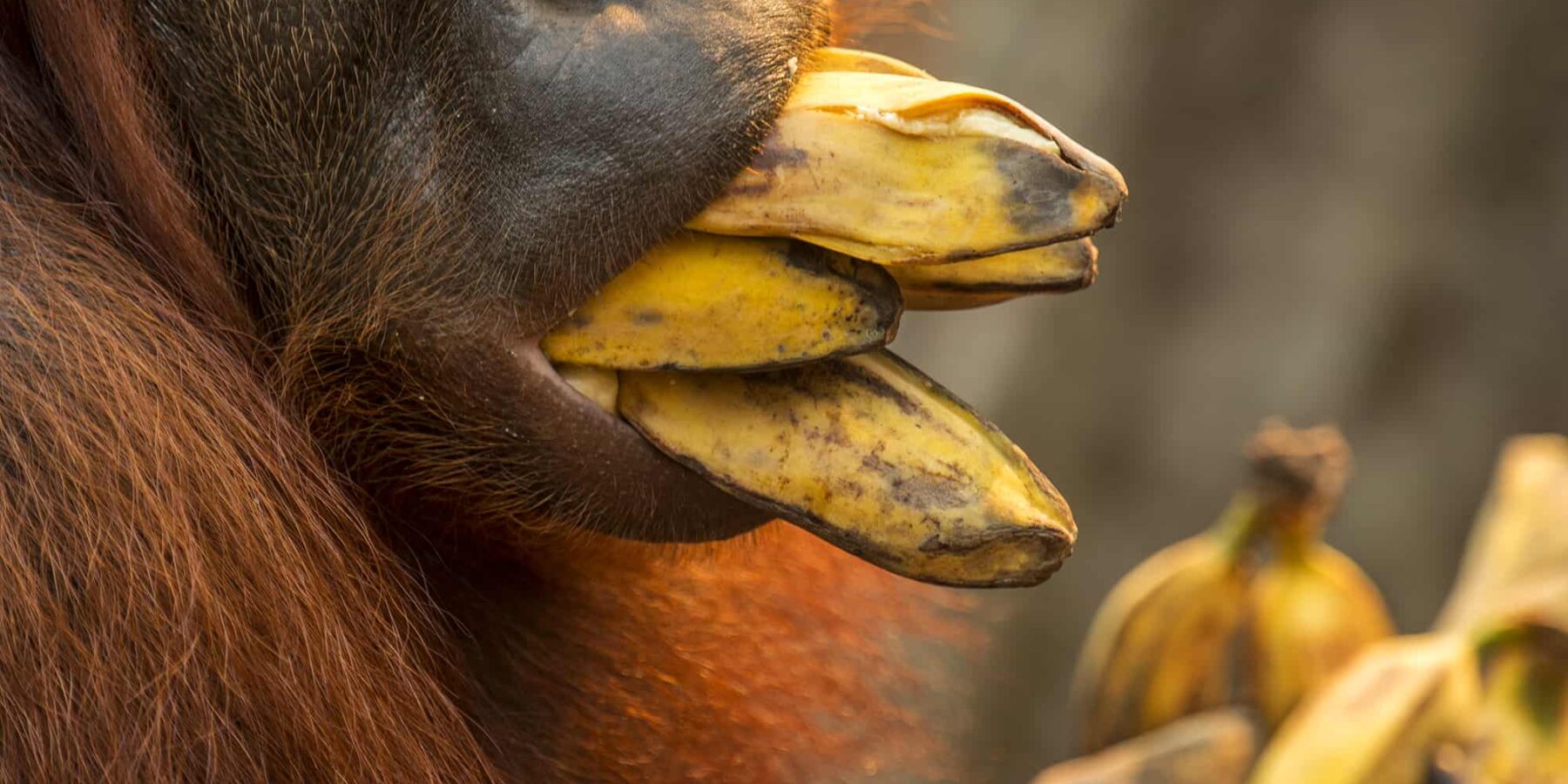
WHAT IS THE BEST TIME TO GO SEE ORANGUTANS IN BORNEO? AND WHERE?
Spotting these incredible human-like animals is an incredibly popular experience for any traveller to Borneo. There are various ways in which you can see them; in the wild, captive or in a semi-wild environment – like an orangutan sanctuary -. We are here to answer the question: Where is the best place to see orangutans in Borneo? Along the way, we provide tips on how to spot these amazing creatures and have the best overall experience.
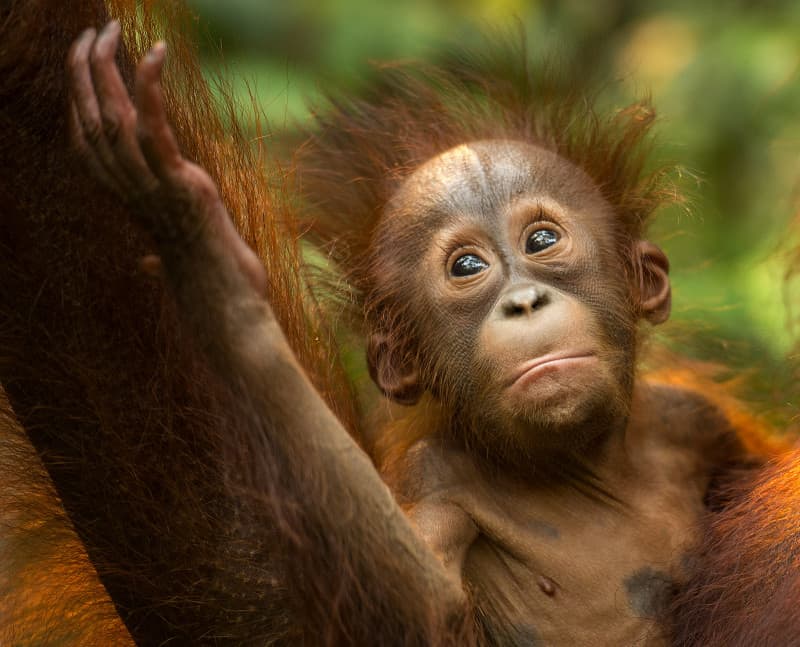
How many Orangutans are left in Borneo?
Whilst in 2006 there were an estimated 66,000 orangutans in the world, now there’s thought to be only 45,000 – an incredibly steep and fast decline. The prospect of seeing such a unique and clever creature at risk of disappearing in the next few decades is a powerful draw. So here’s how to best see orangutans in Borneo, locally known as the “people of the forest.”
Is it best to see Orangutans in Borneo in the wild or in a rehabilitation centre?
When choosing your Borneo orangutan experience, be prepared that each will have its pros and cons depending on whether you see them in the wild or in a semi-wild environment. Factors like how fit you are, the time of year, and how you would prefer to travel can also influence where the best place is for you to see orangutans in Borneo. You can read our guide to the best rainforests of Borneo for a guide on the different wild environments available to you. Combining both experiences gives you a fuller picture of the survival of this animal, but it really depends on how much of a focus Orangutans are during your Borneo holiday.
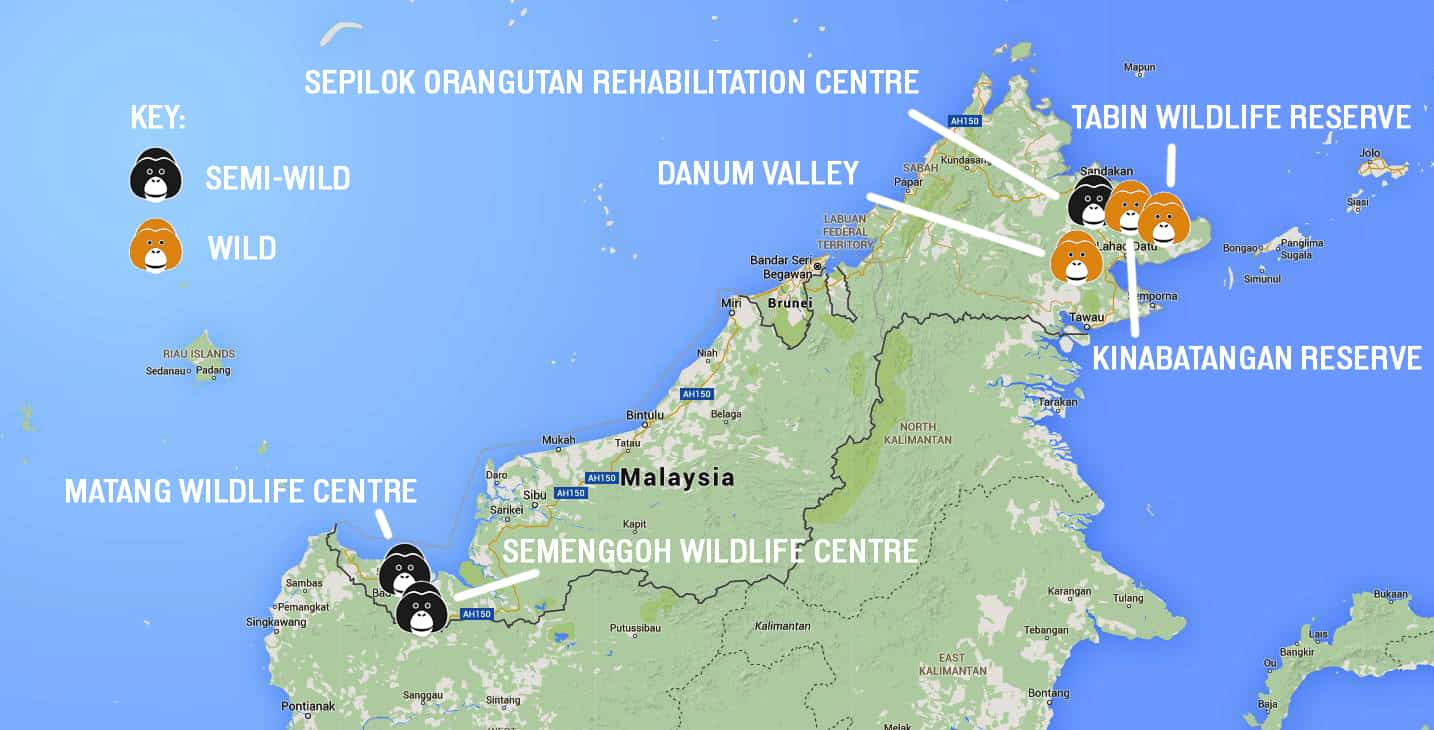

CURIOUS TRAVELLER'S GUIDE TO BORNEO
If you’d like to discover more, why not download the Curious Traveller’s Guide to Borneo? This is where you’ll find our experts’ edit of hotels, experiences and beaches. We also break down the best time to visit Borneo by month and share more information about our approach to conservation in-country.
DOWNLOAD NOW
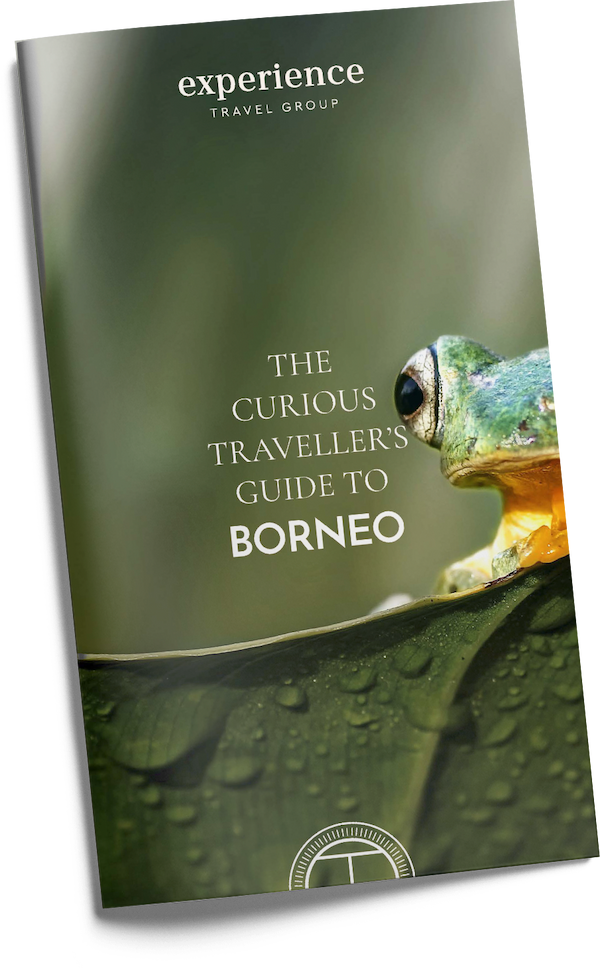
CURIOUS TRAVELLER'S GUIDE TO BORNEO
If you’d like to discover more, why not download the Curious Traveller’s Guide to Borneo? This is where you’ll find our experts’ edit of hotels, experiences and beaches. We also break down the best time to visit Borneo by month and share more information about our approach to conservation in-country.
DOWNLOAD NOWAt a Borneo Orangutan Rehabilitation Centre
Orangutan rehabilitation centres are dedicated to rescuing the orangutan population from habitat loss, poaching and the illegal pet trade. They usually encompass a large area of land, providing orangutans with supplementary food for support before they can leave of their own accord through a rainforest corridor out to the wild. With regular feeding times, you are virtually guaranteed to see an orangutan during your visit, so this is an excellent option if embarking on a Borneo trip solely to see orangutans. This is also a great way to support the efforts to save orangutan populations threatened by human behaviour.
Pros:
- Very high likelihood of sighting
- Relatively close proximity to the orangutans – around 10 feet away
- Good on-site information about the species and passionate naturalists to guide you around
- Money goes towards conservation efforts and those who have the animals best interests at heart
Cons:
- Group environment with other travellers – you don’t know how others might act!
- It is more staged and static, although seeing orangutans swing down from the canopy for feeding time is a sight to behold
There are three popular centres you can visit:
- Sepilok Orangutan Rehabilitation Centre is a 40-minute drive from Sandakan in Sabah. It is the largest rehabilitation centre in the world and has 43 km of protected rainforest for 60-80 orangutans to live in and hopefully leave once they’re ready to fend for themselves in the world
- Semengoggoh Wildlife Centre is a 30-minute drive from Kuching and is the largest rehabilitation in the western state of Sarawak. It boasts 7 km of forest reserve for around 30 semi-wild orangutans to inhabit
- Matang Wildlife Centre is in the Kubah National park and is a 40-minute drive from Kuching. It specialises in looking after orangutans with previous issues such as territorial and aggressive behaviours. The apes are kept in enclosures and large cages, and this is a less frequented centre as it provides quite specialist care. We mention it here for travellers particularly interested in the rehabilitation of difficult individuals or for those especially knowledgeable and/or specialised in wildlife
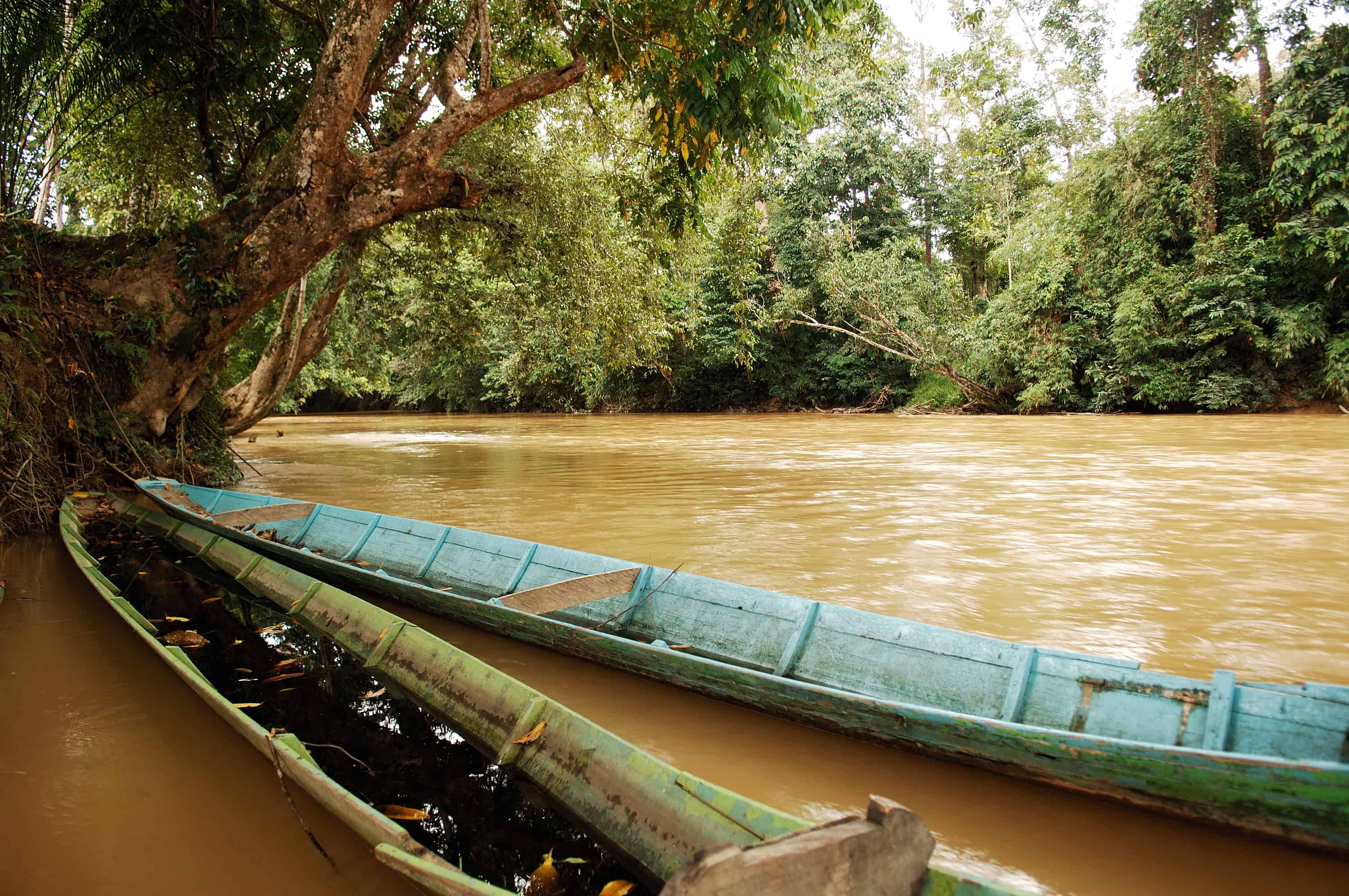
When is the best time to go to Borneo to see Orangutans?
May through to the end of September is the best time of year to see Orangutans in Borneo, both at the rehabilitation sanctuaries and in the wild. This coincides with the best time of year to visit Borneo in general. In the wetter part of the year, from October through to mid-March, the rain makes the vegetation slightly thicker and – as with anywhere in the world, things aren’t quite as fun when you’re wet. The humidity levels also increase during this time too. Having said this, the wetter time of year does mean fewer tourists and, unlike nearby countries, you don’t get fierce typhoons or constant monsoon rains. When thinking about what time of day is best to see Borneo’s orangutans, this will depend on the type of viewing experience you are planning. At orangutan sanctuaries, feeding times are your best chance of seeing these majestic creatures, so do your research before visiting to maximise your chances.
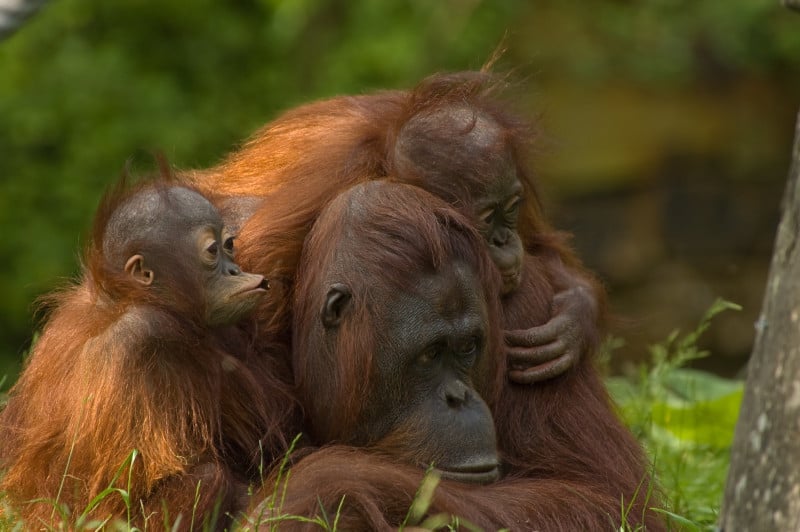
Seeing Orangutans in the wild in Borneo
Nothing quite beats a wild sighting of this majestic species in the treetops of Borneo’s virgin rainforests. There’s a magical quality to the spontaneity of the moment and, whilst there isn’t a guaranteed sighting, if you do see an Orangutan it makes the experience all the more special.
Pros:
- An intimate experience, away from other travellers
- See other wildlife like Proboscis monkeys and birdlife
- Natural habitat makes for an authentic experience
Cons:
- You might not see orangutans – there is no guarantee
- The apes are harder to spot in the canopy than in a rehabilitation centre
- Orangutans can be metres up in the air, making it difficult for photographers or those wanting to get a little closer
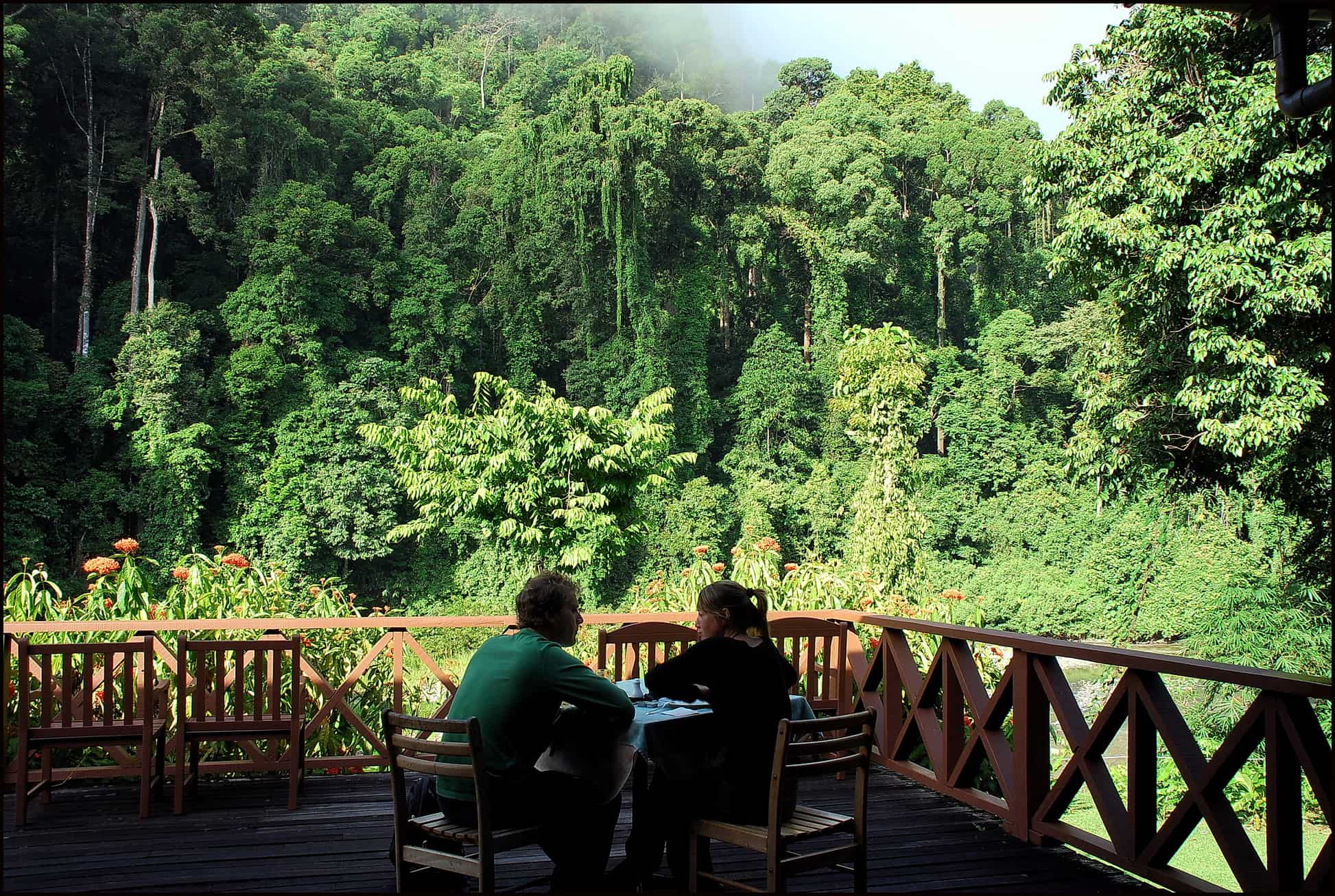
Where is the best place to see Orangutans in Borneo in the wild?
Once again, the best place to see orangutans in Borneo is unique to you. You should consider how fit you and your travelling party are and how comfortable you want to be while attempting to catch a glimpse of orangutans. There are plenty of options, whether you’d enjoy being out in the wild and having fun, stay seated with a guide for help, or prefer to walk around at your own pace.
Tanjung Puting National Park
Tanjung Puting National Park. The best place to see orangutans in Borneo in the wild, in our opinion, is actually in Kalimantan, the Indonesian part of Borneo.. Wild orangutans sightings are all but guaranteed as you explore the vast waterways by Klotok for a few days, which is a unique experience in itself. Do note that unless you have 3 weeks or so, including Tanjung Puting National Park is logistically best during a trip combined with Java in Indonesia, as flight connections work best this way. Please note that It takes at least one day and night of travel to get from Malaysian Borneo to Tanjung Puting National Park including three flights.
How to get to Tanjung Puting National Park:
Things can change quickly, but generally speaking it’s a little tricky! A visit is best combined with an Indonesia trip, as flight connections to the nearest airport (Pangkalanraya (PKY)) are not great and better from the island of Java. You can get direct flights from Jakarta, Surabaya and Semarang (although not every day from each airport) and back to all. You can also connect to Bali on the same day though, if flying from PKY airport. You can’t get from Malaysian Borneo straight to Pangkalanraya on any flights (as of April 2022).
Kinabatangan Wildlife Reserve
Kinabatangan Wildlife Reserve encompasses the Kinabatangan river – the second-largest in Malaysia and home to a large and wonderful array of wildlife. This is a really fun way to spot orangutans as usually the best way to navigate this area is on the river itself.
How to get to Kinabatangan Wildlife Reserve:
International flights are well connected to Sandakan (SDK), the nearest airport. We’d recommend at least one night in Sepilok, which is an hour from Sandakan, before taking a boat to the Kinabatangan – which is a wildlife experience in itself and much better than driving from Sepilok to the Kinabatangan. It then connects easily to Tabin and Danum as well. You can also fly from Kuching/ Kota Kinabalu to Sandakan easily if you are exploring Borneo from either Sahah or Sarawak.
The Danum Valley
The Danum Valley – home to orangutans, as well as other various species of flora and fauna – is one of our favourite rainforest experiences in Borneo. It’s here that Prince William and Kate visited in 2012 as part of the Diamond Jubilee tour. Composed entirely of virgin rainforest, this is really the creme de la creme of wild Bornean rainforest.
How to get to Danum Valley:
The nearest airport is Lahad Datu (LDU), which has great connections to Kota Kinabalu and onwards to Kuala Lumpur. Must people arrive from the Kinabatangan (circa 7 hours door to door including registration in lahad Datu, and the jeep drive into the reserve) or from Tabin (circa 5 hours door to door). But you can fly straight from Kota Kinabalu (1 hour) and have an extended stay in just Danum Valley, which is a few hours drive from Lahad Datu airport.
Tabin Wildlife Reserve
Tabin Wildlife Reserve in Sabah is home to elephants, endangered forest cows and orangutans as well as various other animals. It protects some virgin rainforest, as well as a secondary rainforest, with some oil plantations, so you really get a sense of the changing landscape of Borneo.Tabin is also a particularly good place for birding.
How to get to Tabin:
See how to get to Danum Valley. It’s a 1.30-2 hour drive from Lahad Datu airport, in the opposite direction to Danum valley. Alternatively it’s a 5 hour drive from Kinabatangan National Park.
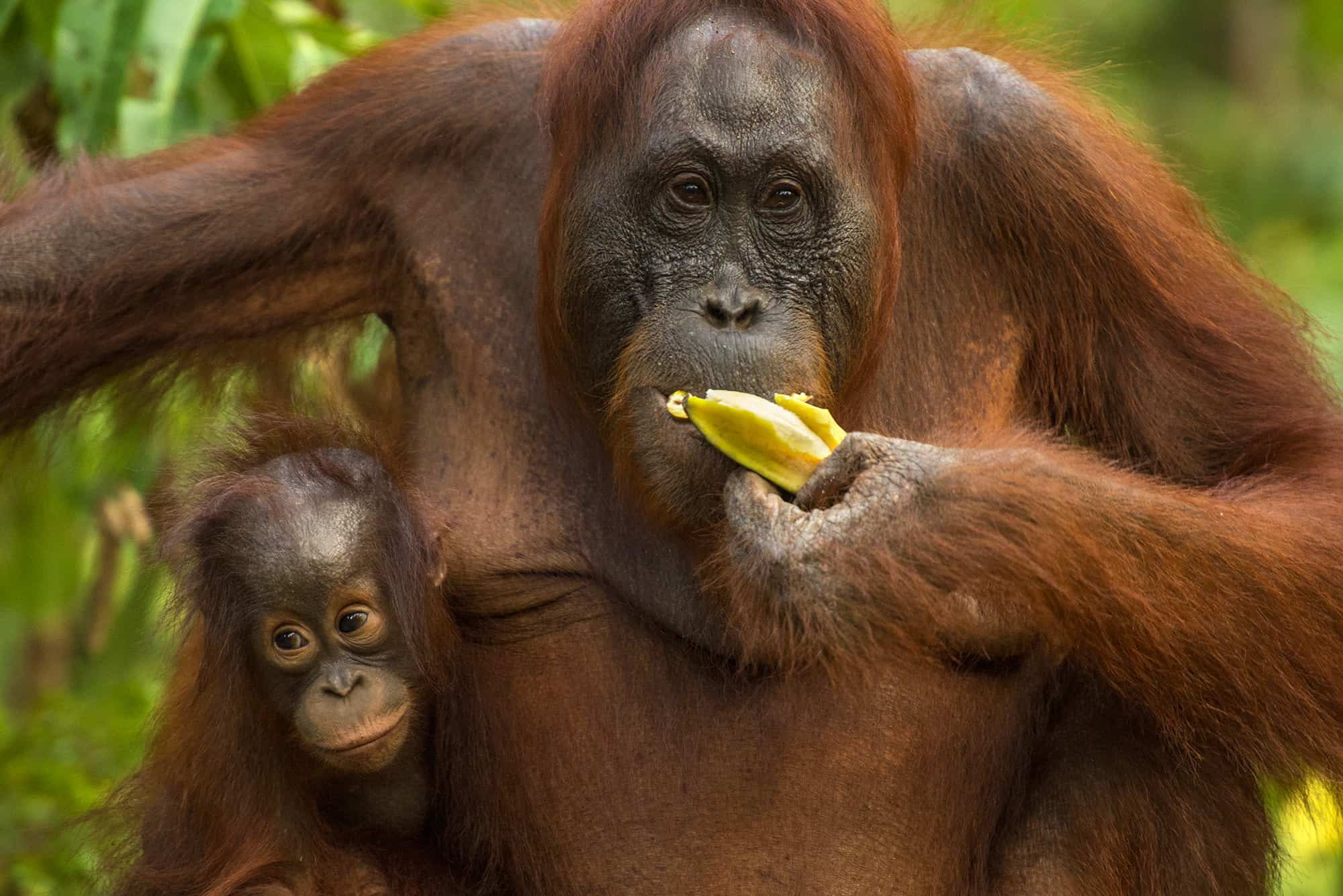
What are the best tips for spotting Borneo Orangutans in the wild?
Do:
- Go prepared. Read up on orangutans before you go or, alternatively, watch some documentaries. ‘The ape who went to college’ is about Chantek, the orangutan who learned sign language at an incredible rate but was later put into a research facility that ultimately led to his tragic isolation. It really questions the boundaries of what is human and what is animal behaviour.
- Ask questions when visiting a rehabilitation centre. This is the place to do it as you’ll be surrounded by experts in the best position to give you live replies to all your questions!
Embrace getting off the beaten track. It will help you better appreciate the environment orangutans are adapted to live in. - Take a zoom lens for photography – anything over 100mm is ideal. This means you don’t have to disturb the animal and you’ll still get a really good close up shot.
- Embark on your wild orangutan adventure with an open mind. There may be leeches, mosquitoes and you’ll sweat a lot, but the pay-off of seeing these creatures in the wild is more than worth it.
- Go during the low season to avoid the crowds. Although obviously not an option for everyone, this makes the experience even more special.
- Avoid the wet season when trekking in the wild because of heavy rainfall and leeches!
Don’t:
- Expect to get very close to orangutans; we share 96% of their genes and can swap diseases easily. Even a mild cold might seriously harm them.
- Expect to cuddle baby orangutans. Rehabilitation centres’ main priority is to help build their strength so that, as adolescents, they can fend for themselves. This means they need to grow up in as wild an environment as possible

CURIOUS TRAVELLER'S GUIDE TO BORNEO
If you’d like to discover more, why not download the Curious Traveller’s Guide to Borneo? This is where you’ll find our experts’ edit of hotels, experiences and beaches. We also break down the best time to visit Borneo by month and share more information about our approach to conservation in-country.
DOWNLOAD NOW

CURIOUS TRAVELLER'S GUIDE TO BORNEO
If you’d like to discover more, why not download the Curious Traveller’s Guide to Borneo? This is where you’ll find our experts’ edit of hotels, experiences and beaches. We also break down the best time to visit Borneo by month and share more information about our approach to conservation in-country.
DOWNLOAD NOWWhen is the best time of day to see orangutans and why?
The animals are most active from sunrise to 9am, and between 2pm and sunset. This is when the temperature is cooler and therefore very active feeding. In the middle of the day they are usually resting.
How to best support conservation of orangutans?
There are less than 100,000 orangutans left in Borneo. The population has declined by 60% in the last 100 years. To do your bit, support organizations on the ground like HUTAN, KOPEL and Borneo Orangutan Survival Foundation; all are doing great work to save the species and their forests.
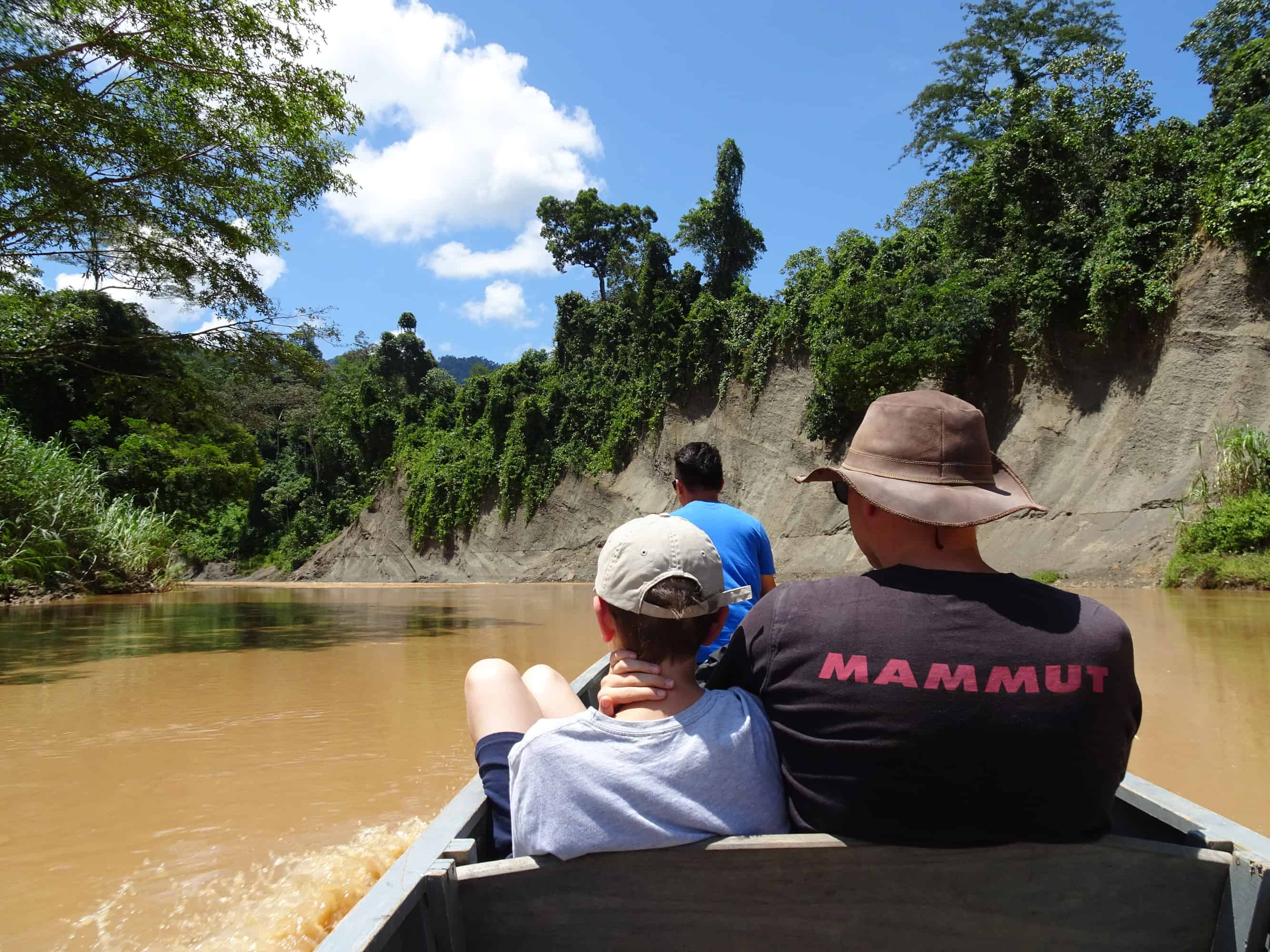
Orangutan accommodation options – considering budget and personal fitness levels
Choosing Danum Valley
Borneo Rainforest Lodge is very special (a 4/5 star property in the heart of primary rainforest – pretty unique across the whole world),but it does come at a cost. It is the most expensive accommodation option in Borneo, but understandably so. If you’re there for two nights it’s best to be relatively fit (or at least comfortable with a couple of hours hiking) so that you can hike along the forest floor and up some steep inclines or go tubing – to really make the most of your time. If you want to spend longer (always recommended subject to budget!) then you can afford to be a little more relaxed and spend more time taking in the sounds and sights of the forest from the property (or even your room). It is quite a bumpy journey from Lahad Datu to the property so do be prepared.
Choosing Tanjung Puting
It’s quite a long journey to get there due to flights from Java, but a relatively easy journey all the same. You need to decide whether you want to stay on a klotok (small boat) or in an eco lodge – or combine the two over a minimum of 2 nights – we usually suggest 2 to 3 nights for most people so that things aren’t rushed. Whilst the accommodation isn’t that expensive, the costs of flights does add up.
Choosing Tabin Wildlife Reserve
A lower-cost version of Danum Valley with not quite as dense forest cover, this is a great economical choice for an authentic rainforest experience. Similar to Danum Valley, a relative level of fitness is required in order to enjoy the experience to the fullest (ideal for those at least comfortable with a couple of hours hiking, although without some of the steep inclines of Danum.
Choosing Kinabatangan River Basin
The most economical even though wildlife sightings are often fantastic. Again a relative level of fitness is best but it is the most relaxing of the four best options as you often use the boardwalks of properties or get around via boat. Make sure you’re comfortable being on boats though, and are ok with being sat down in a dug-out canoe style boat…but what an experience!
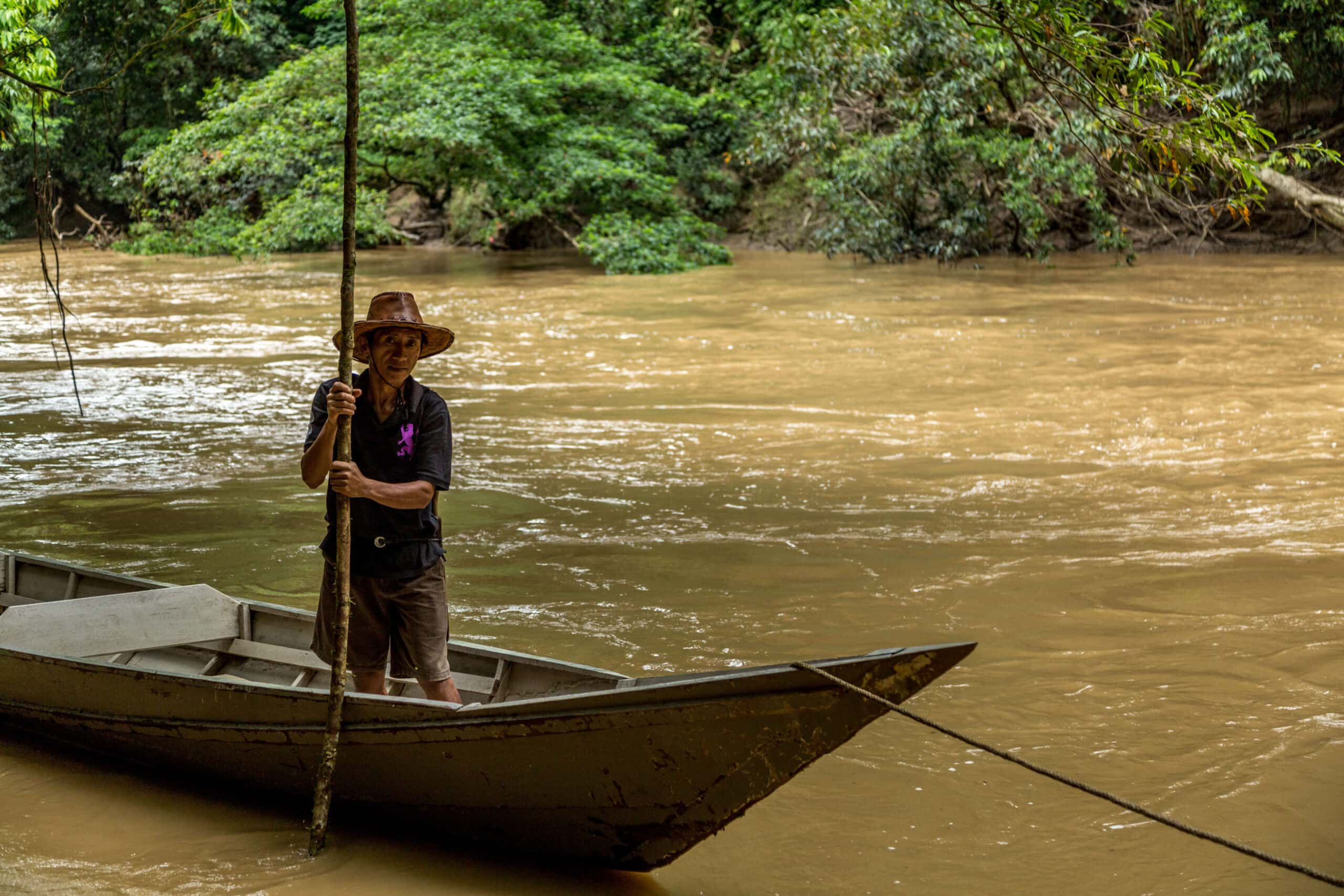
CURIOUS ABOUT BORNEO HOLIDAYS?
All of our Borneo holidays are tailor-made so we can tweak experiences and hotels to wherever you’d like. If you’d like to talk to us about the best places to see orangutans in Borneo, you can always phone on 020 7924 7133 . There are absolutely no obligations and we’re here to offer advice for any stage of your holiday planning.
Alternatively, fill out an online enquiry form to start your journey.

